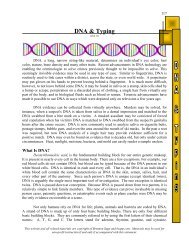You also want an ePaper? Increase the reach of your titles
YUMPU automatically turns print PDFs into web optimized ePapers that Google loves.
<strong>Dusting</strong><br />
<strong>Dusting</strong> is the most effective way to<br />
obtain a print from a ridged non-porous<br />
surface such as glass, plastic, or metal<br />
surfaces. Using a camel hair brush, black<br />
carbon or aluminum powder is placed over<br />
the location of a suspected print. The dust<br />
adheres to the sweat and oil left behind by the<br />
person who touched the surface. Next, wide<br />
transparent tape is smoothed over the dusted<br />
area. When the tape is then removed from the<br />
surface, the dust and the print will be<br />
attached. Finally, the tape is placed onto a<br />
white card for display and comparison.<br />
Below, the print on the left was developed by<br />
dusting with carbon powder; the print on the<br />
right, using aluminum powder.<br />
<strong>Iodine</strong> <strong>Fuming</strong><br />
<strong>Iodine</strong> fuming is an excellent way to develop<br />
prints on porous and non-porous surfaces such as paper,<br />
index cards, magazines, and cardboard. To fume a<br />
suspected latent print, the surface must be placed into a<br />
container with solid iodine. The sublimation of iodine<br />
in a closed container will cause iodine vapors to<br />
concentrate, then be absorbed by the oil and sweat left<br />
behind by human skin. The temporarily-developed<br />
print will then be visible as an orange/brown outline.<br />
Upon development, the print should be photographed<br />
for documentation. The iodine will eventually sublime<br />
from the surface of the print, allowing the print to return<br />
to its latent state. The surface is then returned to its<br />
original appearance and can even be exposed to<br />
additional developing techniques. At right: a print<br />
developed using iodine fuming.
Ninhydrin Solution<br />
Silver Nitrate<br />
Ninhydrin is a chemical<br />
that reacts with amino acids to<br />
form a purple compound. This<br />
development technique is used<br />
primarily on porous surfaces such<br />
as paper, tissue, and clothing. The<br />
white powder ninhydrin must be<br />
dissolved in acetone before it can<br />
be soaked into a surface for<br />
development. The reaction will<br />
then develop the print within<br />
twenty four hours. Left:<br />
developing a print with a<br />
ninhydrin-acetone soaked brush.<br />
Right: a print developed by<br />
reacting with ninhydrin.<br />
When exposed to ultra-violet (UV) light, silver nitrate reacts with the salt in sweat to form a blackish-brown compound. Using this reaction, a suspected<br />
object is sprayed with a silver nitrate solution and the left to develop under a UV bulb. The print should become visible in five to ten minutes. This type of<br />
development is best used on porous surfaces, like paper or drywall. Top left: Spraying print with silver nitrate solution. Top right: UV light hood. Left: a print<br />
developed using silver nitrate solution and exposed to UV light.
In recent years, there has been much<br />
advancement in the area of print<br />
developing. The use of advanced<br />
brushes and new chemical procedures<br />
make it possible to develop prints on a<br />
larger variety of surfaces. Some<br />
criminals wear gloves to avoid leaving<br />
fingerprints at a crime scene, but often<br />
they discard the gloves nearby. This<br />
is a picture of latent prints developed<br />
on the inside of a glove.







